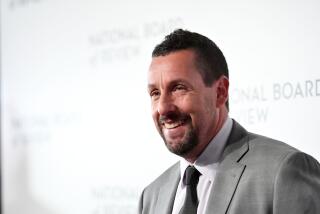Horror director Ti West takes a shot at western ‘In a Valley of Violence’ with Ethan Hawke, John Travolta
There are plenty of ways in which the South by Southwest Film Festival has grown in scale over the years. But it is still the kind of event where one might run into a filmmaker such as Ti West on an Austin, Texas, street corner the night before the world premiere of his much-anticipated western, “In a Valley of Violence.”
And he will stop to chat for the cycle of a couple street lights, professing his seemingly genuine enthusiasm for the new film and how excited he is for people to see the performances by Ethan Hawke and John Travolta.
All of which was born out Saturday night when West first revealed “Valley,” a movie that alternates between a grim seriousness and rollicking abandon. Think of it as intense fun.
Set sometime shortly after the end of the Civil War, “Valley” casts Hawke as Paul, a man trying to make his way down to Mexico with his dog. In a small town set in a remote valley, Paul runs afoul of the local sheriff (Travolta) and his hotheaded son/deputy (James Ransone). Even as he tries to get away from the town, Paul finds himself drawn back. The supporting cast includes Karen Gillan and Taissa Farmiga as sisters who run the local hotel.
After the premiere screening, West took the stage at the Stateside Theatre with Hawke, producer Jason Blum and supporting actors Larry Fessenden, Toby Huss and Tommy Nohilly along with a few other members of the crew.
This is the fourth world premiere West has had at SXSW going back to his debut in 2005 with “The Roost.” West made his name directing horror films such as “The House of the Devil” and “The Innkeepers” and so the first question inevitably had to do with why West decided to make a western.
“I just felt like it was time to try something else,” West said. “You make a series of movies in a row and you want to try something different.”
He added that his previous movie, 2013’s “The Sacrament,” was steeped in an attempt at realism, and that in response he felt, “As a filmmaker I wanted to make something that was quintessential traditional cinema, and for me, especially for American cinema, that is a western. As a filmmaker it’s a dream to make a western. So I thought, let’s give it a shot.”
“There’s a little horror in there,” interjected Blum. “A smidge.”
The film, from its title design to Jeff Grace’s evocative score, seems to have been influenced by the Italian westerns of Sergio Leone. Responding to a question about the effect of so-called spaghetti westerns on his own film, West said, “There’s a sort of absurdist nature to them and that to me is what’s fun about cinema, is when it’s not always about reality, it’s about heightened reality. And those movies go way out with that. And that’s certainly baked in to some degree.”
Inevitably, a question came up about the dog in the film. (It’s pretty incredible.) Hawke noted that the dog was trained by the same person who handled Uggie, the dog from the Oscar-winning “The Artist.”
“The dog was a huge fan of ‘White Fang’ and had seen a lot of my earlier work,” Hawke joked, noting the 1991 adaptation of the classic Jack London story he had appeared in, while also referring to his co-star as “an elite animal performer.”
Hawke went on to say that he likes working with animals because “they don’t know you’re acting. So if they sense you’re acting, they get all freaked out and won’t act because you seem weird, right? So I always think it would be the greatest acting tutorial, would be to take young people and have them work with animals.
“Jack Lemmon, who I worked with when I was younger [in 1989’s “Dad”], said it was like working with Marilyn Monroe,” Hawke continued. “They were always going to use the take that Marilyn was good in, never the take that you were, so you had to be good all the time. So that’s what it’s like working with a dog.”
Follow on Twitter: @IndieFocus
More to Read
Only good movies
Get the Indie Focus newsletter, Mark Olsen's weekly guide to the world of cinema.
You may occasionally receive promotional content from the Los Angeles Times.







